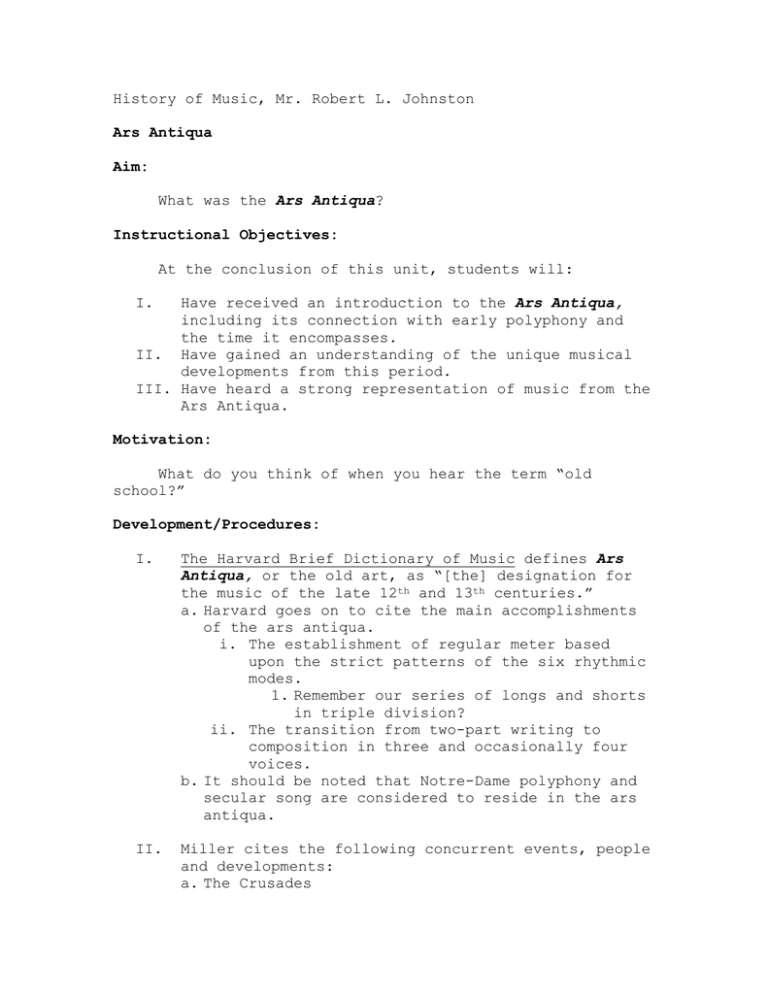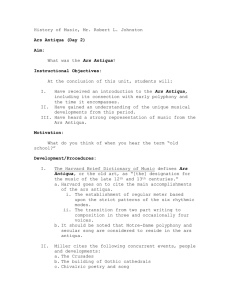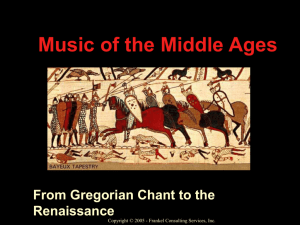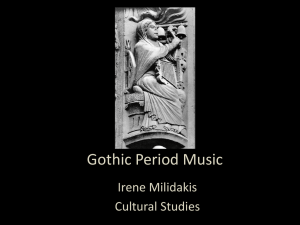History of Music, Mr. Robert L. Johnston I.
advertisement

History of Music, Mr. Robert L. Johnston Ars Antiqua Aim: What was the Ars Antiqua? Instructional Objectives: At the conclusion of this unit, students will: I. Have received an introduction to the Ars Antiqua, including its connection with early polyphony and the time it encompasses. II. Have gained an understanding of the unique musical developments from this period. III. Have heard a strong representation of music from the Ars Antiqua. Motivation: What do you think of when you hear the term “old school?” Development/Procedures: I. The Harvard Brief Dictionary of Music defines Ars Antiqua, or the old art, as “[the] designation for the music of the late 12th and 13th centuries.” a. Harvard goes on to cite the main accomplishments of the ars antiqua. i. The establishment of regular meter based upon the strict patterns of the six rhythmic modes. 1. Remember our series of longs and shorts in triple division? ii. The transition from two-part writing to composition in three and occasionally four voices. b. It should be noted that Notre-Dame polyphony and secular song are considered to reside in the ars antiqua. II. Miller cites the following concurrent events, people and developments: a. The Crusades b. The building of Gothic cathedrals c. Chivalric poetry and song d. The rise of European universities e. Feudalism f. St. Francis & St. Clare g. Roger Bacon h. St. Thomas Aquinas III. Miller goes on to state that the geographical center of the ars antiqua was Paris. a. What famous Parisian cathedral have we discussed? IV. One of the major musical elements of the ars antiqua was cantus firmus. a. The cantus firmus was a pre-existing chant which had voices added around it to create a polyphonic work. i. We call the voice the cantus firmus is in the tenor. V. The following theoretical elements were found in the beginning of the ars antiqua (Miller): a. Extensive use of tempus perfectum b. Extensive use of the rhythmic modes c. Harmony was still dominated by the perfect intervals d. Minimal use of instruments i. Still not notated ii. Still generally doubled or imitated the voice iii. This will change as the period evolves and different forms develop VI. Aside from organum, the following forms developed (Miller): a. The polyphonic conductus i. Flourished in the first half of the 13th century ii. Parts moved together in similar rhythm iii. The tenor was originally composed, as opposed to cantus firmus 1. This is a unique characteristic of the polyphonic conductus iv. Non-liturgical v. Mostly syllabic style vi. Two three and four parts vii. Play Ave virgo virginum (2:05) b. The hocket i. Means hiccup ii. Found in 13th and 14th century polyphony iii. One melodic line had a rest while the other continued and vice-versa iv. Play Bologna’s Fenice fu (2:45) c. Perhaps the most important development of the Ars Antiqua was the motet. i. The Harvard Brief Dictionary of Music describes the motet as “the most important form of early polyphonic music, from c. 1200 to c. 1600.” ii. Miller describes the motet as follows: 1. A plainsong was selected for the lower part 2. It was modified to fit a rhythmic mode 3. Two parts were added above it a. The motetus i. Words were added to this part b. The triplum 4. The motetus and the triplum were faster moving parts than the lowest voice (tenor). 5. All three parts had different texts a. Therefore the title of a motet is a combination of the first words from each of the three parts b. The text could be either sacred or secular, or even both 6. Usually in triple meter 7. Play Motet-Salve, salus hominum-O radians stella-nostrum (1:07) a. Note how motet is titled VII. Shirmer notes the following: a. The motet was the all purpose polyphonic genre of the 13th century b. The three-voiced, double texted motet was the predominant form of the ars antiqua c. Texts and music were interchangeable i. New text for old music is called contrafacta d. Some motets even mixed liturgical and secular texts e. Ultimately, the motet will be the form to usher in the Ars Nova. f. New compositional trends favored ease of performance and aural attractiveness. g. Thus, the more philosophical and mathematical aspects started to become a thing of the past. h. Multiple languages started to be used in different voices in the same work. i. The motet is what ultimately led to the development of mensural, and specifically Franconian style and a much more syllabic setting. i. Ultimately achieved a high degree of accuracy in representing relative duration. (Miller) ii. A style of mensural notation is Franconian notation, 1. Named after Franco of Cologne, who codified it in Ars Cantus Mensurabilis (ca. 1260) 2. This system uses the same kind of notes as modal notation, but the brevis became the basic unit (much like our quarter note) and was still predominantly perfect. a. This was called Tempus perfectum. b. Duple divisions were called Tempus imperfectum. iii. In short, the motet also led to the evolution of notation. VIII. There were two major styles of motets to develop prior to the ars nova. (Shirmer) a. The Petronian style i. Named after Petrus de Cruce (Pierre de la Croix) ii. Fast, speechlike triplum iii. Slower duplum or motetus iv. Chant derived tenor in strict rhythmic patterns b. The other style i. Employed a French secular tenor ii. More equal rhythmic patterns IX. Other abandonments (Shirmer) a. A move to duple based rhythmic structures b. This is generally, the end of medieval times X. Listening example a. Aucun vont -- Amor qui Cor – Kyrie (2:39) b. Discuss Materials of Instruction: Smart Board Norton Anthology Of Western Music, Vol. 1 (Disc 2) The Norton Anthology of Western Music, Volume I Summary: Though we did not quite experience anything too new this lesson, the musical world is about to explode with the development of the motet, which is, in my opinion, the door to opera. This is both musically and historically the end of the Middle Ages. We will move on from here to an extraordinary body of unique and beautiful music, and very colorful characters. We will also be much more composer based from this point forward. Again, the motet is an eminently important study in Music history and the development of our art. I cannot encourage enough, the importance of individual exploration. Assignment: If you have not done so, continue your Monty Python and the Holy Grail worksheets. It’s that time of year where we’re all really, really tired. Get some well-deserved rest and be ready for class the rest of the week! Bibliography: History of Music, Hugh H. Miller, Barnes & Noble Books, New York. 1972 The Harvard Brief Dictionary of Music, Willi Apel and Ralph T. Daniel, Washington Square Press, New York. 1960 Norton Anthology Of Western Music, Vol. 1 (Disc 2), (c) W.W. Norton & Co., Inc. (p) 1988 Sony Special Music Products Shirmer History of Music, Leonie Rosenstiel, general editor, Schirmer Books, New York. 1982 Suggested Reference: History of Music, Hugh H. Miller, Barnes & Noble Books, New York. 1972 Robert L. Johnston



